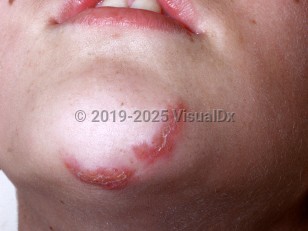Berylliosis, or chronic beryllium disease (CBD), is a chronic granulomatous lung disease involving the airways, lymph nodes, and lung parenchyma caused by inhalation of beryllium, a lightweight metal used in a variety of industrial applications, including in manufacture of metal, metal alloys, and ceramics; electronics; and in the defense and aerospace industries. Lung biopsy in this condition is notable for noncaseating granulomas and or mononuclear infiltration.
The prevalence of berylliosis ranges from 1%-5% depending on the industry. Patients exposed to beryllium who are asymptomatic are thought to have immune sensitivity, referred to as beryllium sensitization (BeS), which ranges from 9%-19%. Patients with BeS can progress to CBD. It is thought that the HLA-DPB1 gene confers genetic susceptibility to CBD progression. Between 21 200 and 800 000 workers have been exposed to beryllium in the United States since the 1970s, although it is likely these numbers are underestimates.
Clinical manifestations of disease can occur even with small doses of beryllium exposure and may not happen for months to years (up to 3 decades) after exposure. Common symptoms include nonproductive cough, dyspnea, fevers, night sweats, weight loss, and fatigue. Symptoms of exposure may be mistaken for asthma. Cutaneous nodules can also occur on exposed areas of the skin. Severe disease can lead to cor pulmonale due to pulmonary hypertension. The diagnosis is confirmed with a positive beryllium lymphocyte proliferation test (BeLPT) and noncaseating granulomas or interstitial cell infiltration on lung biopsy.
Related topic: Pneumoconiosis
Berylliosis
Alerts and Notices
Important News & Links
Synopsis

Codes
ICD10CM:
J63.2 – Berylliosis
SNOMEDCT:
8247009 – Berylliosis
J63.2 – Berylliosis
SNOMEDCT:
8247009 – Berylliosis
Look For
Subscription Required
Diagnostic Pearls
Subscription Required
Differential Diagnosis & Pitfalls

To perform a comparison, select diagnoses from the classic differential
Subscription Required
Best Tests
Subscription Required
Management Pearls
Subscription Required
Therapy
Subscription Required
References
Subscription Required
Last Reviewed:05/20/2018
Last Updated:06/21/2018
Last Updated:06/21/2018
Berylliosis

